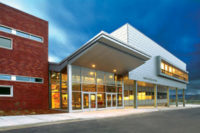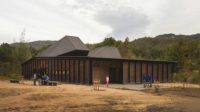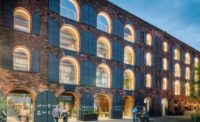Challenge: Transform a ‘70s-era charter school into a state-of-the-art learning center.
Solution: Build an energy-efficient replacement with a profile and materials that reference the school’s folks-y roots and land stewardship.
The Aspen Community School’s sprawling 25-acre campus occupies a spectacular piece of property with 360-degree views of Roaring Fork Valley, one of the most affluent regions in Colorado nestled among rolling hills. In 2014, Scott Lindenau, FAIA, design principal for Studio B Architecture + Interiors in Aspen and Boulder was tasked with giving the K-8 charter school a complete overhaul. The firm won an $11.5-million contract to build a site that included classrooms, a community building, and a gymnasium.
“One of the biggest challenges was the existing campus built in the 1970s by hippie parents who loved the community,” says Lindenau. “As the school evolved, it became more important to have a new facility because nothing was up to code.”
The students, teachers, and administrators wanted the new design to reflect the heart of the original school, which was very rooted in the landscape and in the arts.
“The solution was to design a school that uses environmentally friendly materials like cedar and Douglas fir on the walls and ceilings,” he says. “Wood has a certain warmth to it and we didn’t want to lose that.”
The site itself evoked feelings of nostalgia. For that reason, the architects came up with a building profile that would leave views of the landscape unobstructed—a onestory structure that’s partially buried to make it very low profile. “The school almost becomes a land form so that it doesn’t interrupt the skyline and the stunning views from the valley,” Lindenau says.
Meanwhile, whereas the old building was dark with small windows, the new one enjoys natural light and improved ventilation as a result of generous glazing.
“We used Kalwall in the classrooms and [in the clerestory windows] of the roof lines to build light into the interiors,” he says. The team also installed higher ceilings and taller windows in classrooms to circulate fresh air.
To make up for the fact that there are very few trees on site, Studio B wrapped the west elevation with a 12-foot-long trellised walkway that filters natural light at sunset.
To add energy efficiency where the ‘70s era building previously had none (and lower the school’s building maintenance costs), the architects employed lots of LEDs and low-E glass that lets in light, but limits UV rays, among other solutions. Meanwhile, generous glazing on the west and south elevations is a highly efficient way to let light into the interior. In everything, the team aimed for LEED-certified performance, using less energy and water, and reducing greenhouse gas emissions.
The materials palette inside satisfied a simple equation: durable, eco-friendly, and fun. One example: wall panels of Homasote, a 98-percent-recycled fiberboard that is soft enough to serve as a bulletin board where kids can pin up drawings. In some cases, the panels also clad the ceiling (as in the music room) because they’re dense enough to absorb sound. The 8,000-square-foot gym is built from glued laminated timber, which Lindenau describes as stronger than steel and offers more stiffness than traditional lumber. Studio B also chose reclaimed carpet tiles to cover most of the floors.
At the heart of the school is a community room where students and faculty meet, architects specified seating with storage inside, “so it can be moved around,” says Lindenau, “for a small poetry reading or recital.”
The firm also wanted a no-maintenance exterior, so they selected weathered cedar siding outside the K-4 classrooms. “We’re just going to let that go natural,” Lindenau says. On the exterior of the administration wing, his team installed cement board panels that are mold- and moisture-resistant, and throughout the building they used an aluminum- clad window system, which doesn’t need frequent painting or staining.
“We preserved the school’s history, while bringing it into the 21st century,” he says.









Post a comment to this article
Report Abusive Comment